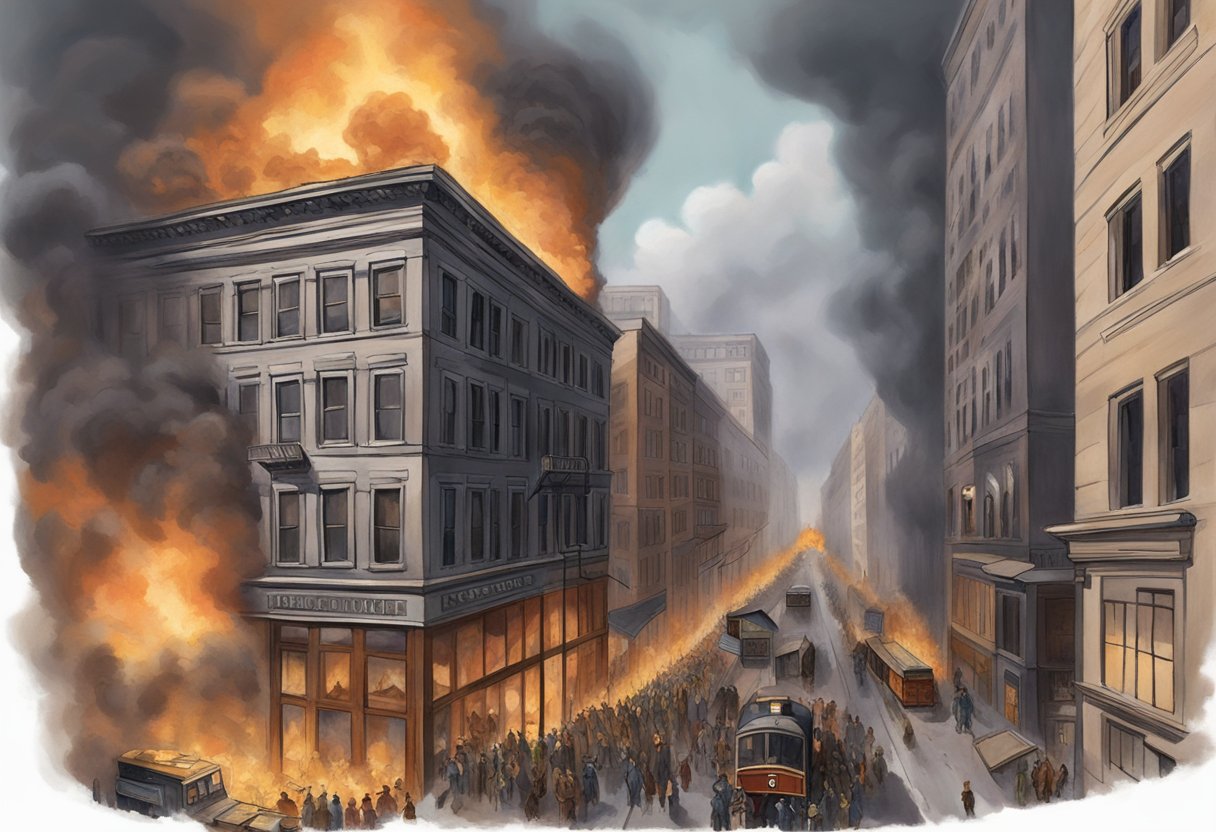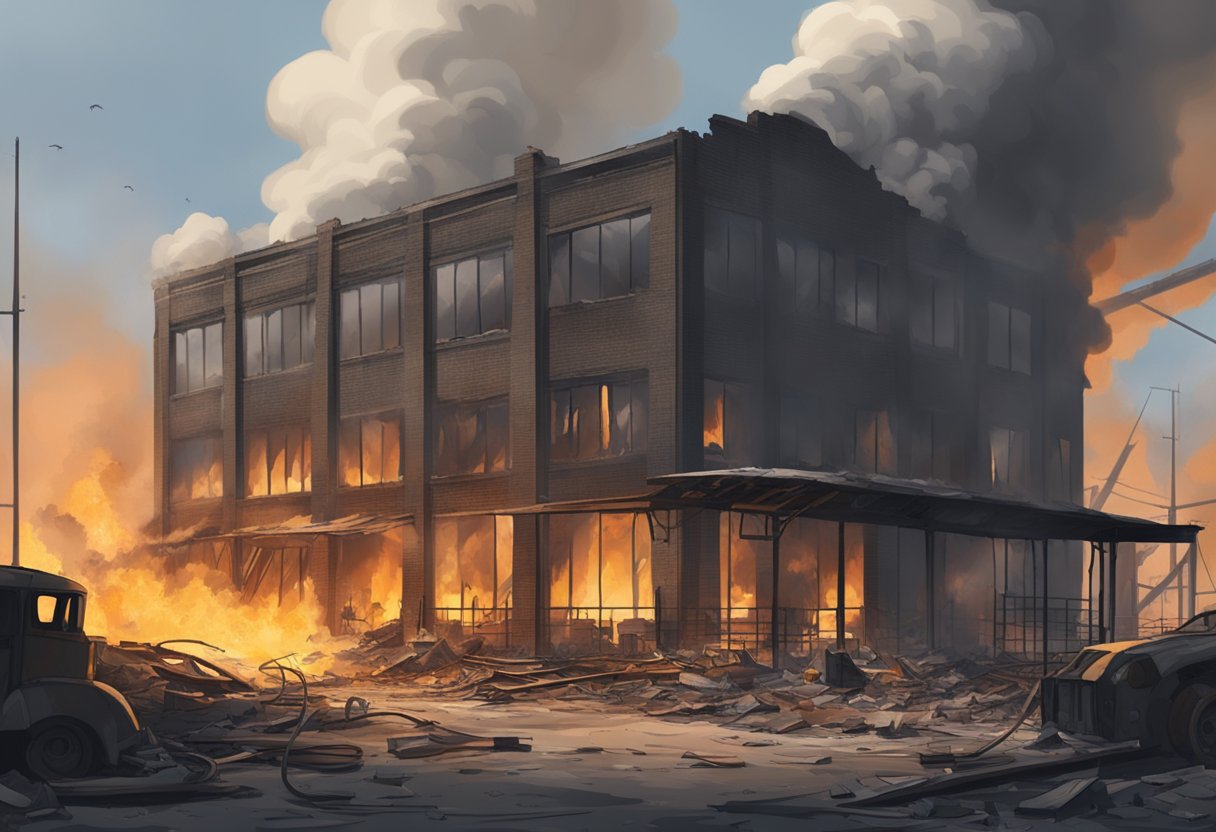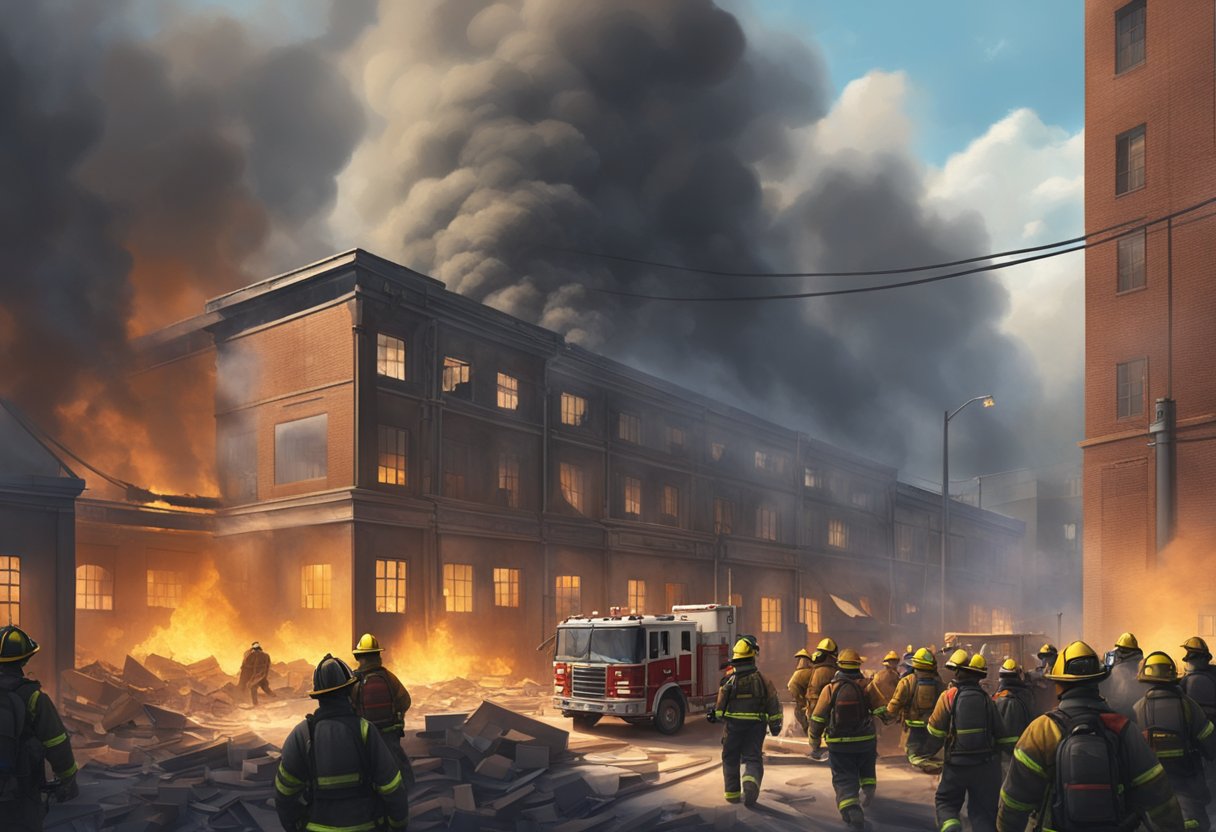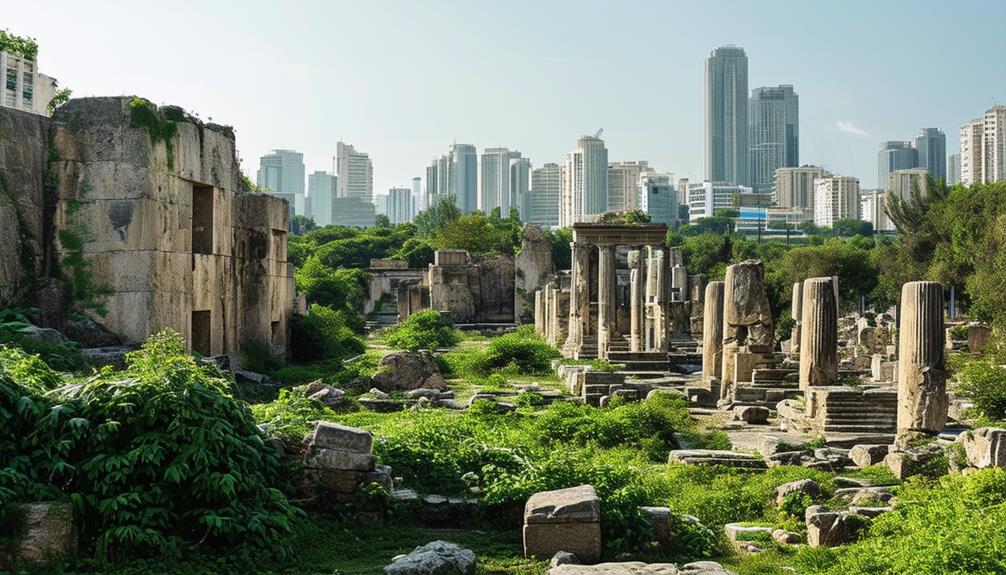The Triangle Shirtwaist Factory Fire: A Tragic Turning Point in Labor Reform History

The Triangle Shirtwaist Factory Fire on March 25, 1911, stands as one of the deadliest industrial disasters in U.S. history. The fire claimed the lives of 146 workers, most of whom were young immigrant women. Trapped by locked doors and poor safety standards, many had no choice but to leap to their deaths from the factory windows.
This tragic event not only shocked the nation but also prompted significant reforms in labor laws and workplace safety. The fire underscored the dire conditions faced by workers in factories at the time and led to public outcry and demands for change.
The aftermath saw the establishment of stricter fire codes, improved factory regulations, and the rise of labor unions advocating for workers' rights. The Triangle Shirtwaist Factory Fire, though devastating, became a pivotal moment that transformed labor laws and heightened awareness about worker safety in the United States.
Historical Context
The early 20th century in New York City saw rapid growth in the garment industry, which largely depended on the labor of immigrant women working in harsh conditions. Sweatshops proliferated, leading to widespread labor exploitation and unsafe work environments.
The Garment Industry in Early 20th Century New York
In the early 1900s, New York City's garment industry was booming. Factories and small workshops produced a large proportion of the clothing for the United States. This demand grew quickly, drawing many workers to the city.
Factory owners sought to cut costs wherever possible. This often meant overcrowding workspaces and pushing workers to their limits. The result was a highly productive yet hazardous environment. Fire hazards were common due to flammable materials and poor safety practices.
Immigrant Women and the Workforce
A significant part of the workforce in the garment industry was composed of immigrant women. Many of these women came from Italy and Eastern Europe. They often did not speak English and faced discrimination.
These women worked long hours for minimal pay. They took these jobs out of necessity to support their families. Many young women, some in their early teens, faced grueling workdays with little rest. Their precarious position made it difficult to fight for better conditions.
The Rise of Sweatshops and Labor Exploitation
Sweatshops became prevalent in the garment industry. These small, crowded workshops had poor ventilation and inadequate fire exits. Employers paid workers by the piece, which encouraged long hours and fast work.
The term "sweatshop" itself reflects the intense and oppressive conditions. Workers, many of whom were young women, endured this exploitation with few protections. High demand for cheap labor led factory owners to prioritize profit over safety.
Fire safety was often ignored. Locked doors, inadequate fire escapes, and cramped spaces contributed to the dangers. This environment set the stage for tragedies like the Triangle Shirtwaist Factory fire, highlighting the urgent need for reform.
The Triangle Shirtwaist Factory

The Triangle Shirtwaist Factory was located in the Asch Building in New York City. The factory employed many young immigrant women who worked in poor conditions. Shirtwaists were a popular fashion item at the time.
The Asch Building and Triangle Waist Company
The Asch Building was a ten-story structure in Manhattan. The Triangle Waist Company occupied the top three floors. The factory primarily produced shirtwaists, a women’s blouse that was very fashionable in the early 20th century. Max Blanck and Isaac Harris owned the company.
The factory was a typical sweatshop of its time. The large open spaces were filled with rows of sewing machines. Each worker operated their machine from morning until night, without breaks.
Working Conditions Before the Fire
Working conditions at the Triangle Shirtwaist Factory were harsh. The laborers, mostly young immigrant women, worked long hours, typically from 7 a.m. to 8 p.m. The pay was very low, and the factory was crowded and poorly ventilated.
The factory had only a few exits, and many doors were locked to prevent theft and unauthorized breaks. This practice made it difficult for workers to escape in an emergency. Additionally, fire safety measures were inadequate, with limited fire escapes and no sprinklers installed.
The Shirtwaist as Fashion
The shirtwaist became a symbol of women's fashion in the early 1900s. It was a blouse that combined the comfort of a shirt with the stylishness of a waist. Made of cotton or silk, the shirtwaist often featured lace, embroidery, and other decorative elements.
Its popularity led to high demand, which in turn kept factories like the Triangle Waist Company busy. This demand also contributed to the poor working conditions, as factory owners prioritized production speed over worker safety.
The Fire and Its Immediate Aftermath

March 25, 1911: The Day of the Fire
The fire started around 4:40 PM on March 25, 1911, at the Triangle Shirtwaist Factory located at Washington Place and Greene Street. The blaze spread quickly, consuming the upper floors of the ten-story building. Trapped workers faced locked doors, inadequate fire escapes, and blocked stairwells. Some workers jumped from the windows, preferring to fall to their deaths rather than be consumed by flames.
The Response of Firefighters and the Public
Firefighters arrived swiftly but faced immense challenges. Their ladders could only reach the sixth floor, while the fire raged on the eighth, ninth, and tenth floors. Life nets used to catch jumpers failed under the weight and impact. The public watched in horror as workers jumped, and efforts by firefighters to control the blaze were hampered by limited equipment and poor building safety standards.
Casualties and the Impact on the Community
The fire resulted in 146 deaths—123 women and girls and 23 men—due to burning, smoke inhalation, and falling. The tragedy deeply impacted the community, spurring public outcry and calls for safer working conditions. The loss of so many young lives, particularly immigrant women, highlighted severe labor and safety issues, leading to significant reforms in labor laws and workplace regulations in the following years.
Legal Outcomes and Public Response

The Triangle Shirtwaist Factory Fire led to significant legal battles and public outrage. It exposed corporate greed, worker exploitation, and political corruption, prompting both legal reforms and public demands for justice.
The Manslaughter Trial of Blanck and Harris
Max Blanck and Isaac Harris, owners of the Triangle Shirtwaist Factory, faced manslaughter charges after the fire. The trial focused on their negligence, particularly for locking exit doors which trapped the workers. The prosecution argued that Blanck and Harris prioritized theft prevention over worker safety, resulting in over 100 deaths.
Blanck and Harris pleaded not guilty, claiming they had no knowledge of the locked doors. Public outrage was immense, with citizens demanding accountability for the tragedy. This trial highlighted the tension between business interests and worker safety.
Manslaughter Charges and Acquittal
Despite the compelling evidence, Blanck and Harris were acquitted of manslaughter charges. The jury found there wasn’t enough proof they knew the doors were locked. This acquittal shocked the public and underscored shortcomings in the legal system’s ability to protect workers.
Following their acquittal, Blanck and Harris faced numerous civil lawsuits. Although they had to pay minor fines, these legal consequences were seen as insufficient. The case underscored the need for stricter workplace safety laws and regulations.
The Role of Tammany Hall and Political Corruption
Tammany Hall, the powerful New York political machine, played a controversial role in the fire’s aftermath. Known for its corrupt practices, Tammany Hall had close ties to business owners like Blanck and Harris. Critics alleged that these relationships influenced the trial’s outcome and the lack of substantial penalties for the factory owners.
Nonetheless, the public demand for reform forced Tammany Hall to support progressive labor laws. The outrage from the fire and subsequent trial pressured politicians to pass legislation improving workplace safety and labor conditions, marking a shift in Tammany Hall's approach to labor issues.
The disaster and its legal aftermath showcased the deep-rooted corruption and galvanized efforts toward significant labor reforms, changing the landscape of worker protection in America.
Labor Reform and Worker Safety

The Triangle Shirtwaist Factory Fire in 1911 was a turning point in American labor history. It drove the push for stronger safety regulations, better working conditions, and fair compensation for workers.
Frances Perkins and the Fight for Safety Regulations
Frances Perkins witnessed the Triangle Shirtwaist Factory Fire and was deeply affected by it. She became a prominent advocate for worker safety. As a result, she worked tirelessly to improve fire safety in factories.
Her efforts led to the establishment of the Factory Investigating Commission in New York, which inspected various workplaces for hazards. Perkins' dedication helped shape the policies that aimed at creating safer working environments.
Eventually, Frances Perkins became the first female U.S. Secretary of Labor. Her leadership played a crucial role in the implementation of safety regulations and labor reforms nationwide.
Legislation for Worker Safety and Compensation
The Triangle Shirtwaist Factory Fire led to significant legislative changes. The Factory Investigating Commission, influenced by the disaster, pushed for laws that addressed fire safety, such as mandatory sprinklers and fire drills.
Senator Robert F. Wagner and Assemblyman Alfred E. Smith were among the lawmakers who supported these changes. They helped pass over 30 laws improving workplace conditions.
These laws included safety measures such as better exit routes and unlocked doors during work hours. Additionally, compensation laws were introduced to ensure injured workers received fair pay. These reforms marked the beginning of a new era for worker rights and labor protection.
The Birth of the New Deal and Its Impact on Labor
The labor reforms inspired by the Triangle Shirtwaist Factory Fire laid the foundation for the New Deal. During the Great Depression, President Franklin D. Roosevelt introduced the New Deal to improve economic conditions and protect workers.
Frances Perkins was a key figure in the New Deal, advocating for measures like the Social Security Act and the Fair Labor Standards Act. These laws ensured minimum wage, maximum working hours, and safer working conditions for laborers across the nation.
The New Deal's impact on labor was profound. It significantly improved worker safety, introduced compensation for injuries, and provided better economic safeguards. These changes reflected the growing importance of worker rights in American society.
Long-Term Influence on Industrial and Labor Policies
The Triangle Shirtwaist Factory Fire had a profound impact on the development of labor laws and industrial policies. It led to the creation of investigative commissions, inspired political reforms, and advanced workplace safety standards in the United States.
Establishment of the Factory Investigating Commission
In response to the Triangle Fire, New York State created the Factory Investigating Commission in 1911. This commission was tasked with examining factory conditions across the state. Led by state politicians like Robert F. Wagner and Alfred E. Smith, they conducted inspections and hearings.
The commission's work revealed widespread safety issues, such as inadequate fire escapes and poor ventilation. Their findings led to new laws that enforced better building standards and fire safety measures.
Reform-Minded Politicians and the New Deal Agenda
The fire empowered reform-minded politicians who would later influence the New Deal agenda. Key figures like Franklin D. Roosevelt, who was influenced by the work of the Factory Investigating Commission, prioritized labor rights and safety.
These politicians advocated for worker protections and inspired broad economic and social reforms under the New Deal. Policies such as the Fair Labor Standards Act established minimum wages, maximum working hours, and child labor restrictions.
Advancements in Workplace Safety Laws
The Triangle Fire prompted significant advancements in workplace safety laws. Legislators passed regulations requiring fire drills, sprinkler systems, and fireproofing in buildings. Employers were also mandated to remove hazards and ensure safe working conditions.
New York's initiative sparked nationwide attention, leading to federal legislation aimed at protecting workers. These laws helped shape modern industrial safety standards and highlighted the importance of government oversight in industrial practices.
Legacy and Cultural Memory
The Triangle Shirtwaist Factory Fire not only marked a dark day in American history but also became a symbol for labor reform and workplace safety. Its memory continues to influence how society views worker rights and safety regulations.
The Symbolism of the Triangle Shirtwaist Factory Fire
The Triangle Shirtwaist Factory Fire stands as an emblem of the fight for labor rights. Situated in Greenwich Village, the factory was the site where 146 workers, mostly young immigrant women, lost their lives. Their tragic deaths highlighted the dire conditions many workers faced.
This event spurred changes in U.S labor laws and building codes. Organizations like the International Ladies Garment Workers Union and the Women's Trade Union League gained momentum. These groups pushed for better workplace safety and workers' rights, leading to significant reforms.
Commemorations and the Importance of Remembering
Every anniversary of the fire, people gather at Washington Place and in Washington Square Park to remember the victims. Flowers, particularly white carnations, are placed at the site, symbolizing the lives lost. These rituals emphasize the importance of not forgetting the past to ensure better future protections.
The fire has been studied extensively by historians and authors, including Leon Stein. It has inspired numerous memorials, books, and documentaries. These commemorations and scholarly works keep the legacy alive and remind society of the continuous need for vigilance in workplace safety.




